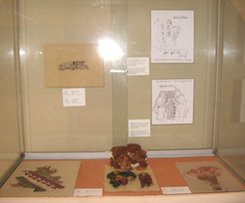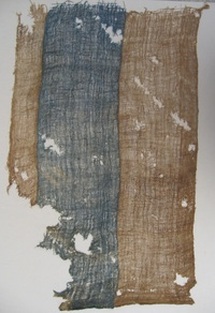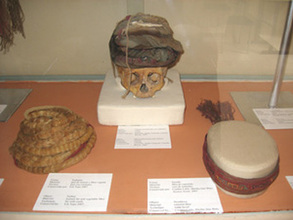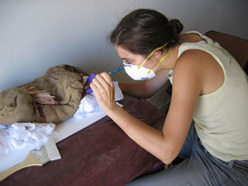Five Years of Conservation Collaboration: Museum Textile Services and Huaca Malena
Inaugurated January 19, 2008

Huaca Malena is a pre-Inca ceremonial complex. During the period of regional development, 400–500 A.D., it functioned as an administrative and religious center. Between 700 and 1100 A.D. the upper platform was used by the Wari culture as a cemetery.
To the ancient Peruvians, textiles played a fundamental role in the dispersion of political and religious ideology. They were used to clothe the body, both in life and in death, as well as for social functions such as paying taxes. Every hand-weaving technique invented anywhere in the world was also known to the ancient Peruvians, which illustrates their ingenuity and resourcefulness.
It is this unique textile legacy that has brought North Americans to the Municipal Museum of Huaca Malena every January since 2004 to collaborate with Peruvians in the conservation of artifacts from the collection. In the last five years over forty textiles, mummy bundles, and mummified heads have been conserved by forty-four participants in this collaborative effort.
By exhibiting the textiles that we have preserved you can share in our voyage of discovery and see for yourself the many stories pre-Columbian textiles tell.
To the ancient Peruvians, textiles played a fundamental role in the dispersion of political and religious ideology. They were used to clothe the body, both in life and in death, as well as for social functions such as paying taxes. Every hand-weaving technique invented anywhere in the world was also known to the ancient Peruvians, which illustrates their ingenuity and resourcefulness.
It is this unique textile legacy that has brought North Americans to the Municipal Museum of Huaca Malena every January since 2004 to collaborate with Peruvians in the conservation of artifacts from the collection. In the last five years over forty textiles, mummy bundles, and mummified heads have been conserved by forty-four participants in this collaborative effort.
By exhibiting the textiles that we have preserved you can share in our voyage of discovery and see for yourself the many stories pre-Columbian textiles tell.
Fiber

The fibers represented in this exhibit come from plants and animals.
The plant fibers are from cotton blossoms, and other stems and leaves. Animal fibers are camelid (such as alpaca hair), leather from animal skins, even human hair and bird feathers. All of these may be used to construct a piece of cloth or as ceremonial ornaments.
Cotton is grown on the coast of Peru and alpaca are raised in the highlands. This tells us that there was trade between different areas of Peru. Fibers may be spun into thread, twisted, plied, looped, or knotted. They are then used to construct fabrics using various techniques such as weaving and knitting.
The plant fibers are from cotton blossoms, and other stems and leaves. Animal fibers are camelid (such as alpaca hair), leather from animal skins, even human hair and bird feathers. All of these may be used to construct a piece of cloth or as ceremonial ornaments.
Cotton is grown on the coast of Peru and alpaca are raised in the highlands. This tells us that there was trade between different areas of Peru. Fibers may be spun into thread, twisted, plied, looped, or knotted. They are then used to construct fabrics using various techniques such as weaving and knitting.
What fibers are used in the clothing you are wearing today?
Structure

The ancient Peruvian concepts of balance and reciprocity have a metaphor in woven structures. At Huaca Malena, thirty-two weave different structures have been found.
The earliest textiles were made with a single thread resulting in open structures such as fishing nets. This evolved into knitting and needle-knitting. Needle-knitting is a structure in which loops are connected to each other to make fabric or fabric embellishment.
When two sets of threads are interlocked, a woven fabric is created. The first set of threads is called the “warp,” and the threads that are interwoven with the warp are called “weft.” When warp and weft are combined in an over-one-under-one manner, the resulting fabric is called “plain weave.”
Gauze is a more complex textile in which the yarns are often highly twisted, making the fabric light and elastic. Sometimes pairs of warp yarns are crossed before the weft is woven in, creating a geometric pattern. Designs can also be created in gauze by combining warp crossing and embroidery.
The earliest textiles were made with a single thread resulting in open structures such as fishing nets. This evolved into knitting and needle-knitting. Needle-knitting is a structure in which loops are connected to each other to make fabric or fabric embellishment.
When two sets of threads are interlocked, a woven fabric is created. The first set of threads is called the “warp,” and the threads that are interwoven with the warp are called “weft.” When warp and weft are combined in an over-one-under-one manner, the resulting fabric is called “plain weave.”
Gauze is a more complex textile in which the yarns are often highly twisted, making the fabric light and elastic. Sometimes pairs of warp yarns are crossed before the weft is woven in, creating a geometric pattern. Designs can also be created in gauze by combining warp crossing and embroidery.

Embroidery is an embellishment of thread generally done after the textile has come off the loom. Embroidery can be done on any type of textile. Brocade is a textile structure that uses additional wefts to create a pattern on the front of the fabric.
To make a thick fabric, heavier yarns can be chosen or a different weave structure can be used. Tapestry is a dense fabric created by packing the weft yarns so tightly that they completely cover the warp. Tapestry is referred to as a “weft-faced” textile. The tightly packed warps are ideal for making dense areas of color such as geometric or figural designs. The finest tapestries look as though they are paintings made of thread.
It is also possible to make a warp-faced textile. The loom is prepared with many warp threads that, when woven, completely cover the weft. This structure is frequently used for belts and other bands.
To make a thick fabric, heavier yarns can be chosen or a different weave structure can be used. Tapestry is a dense fabric created by packing the weft yarns so tightly that they completely cover the warp. Tapestry is referred to as a “weft-faced” textile. The tightly packed warps are ideal for making dense areas of color such as geometric or figural designs. The finest tapestries look as though they are paintings made of thread.
It is also possible to make a warp-faced textile. The loom is prepared with many warp threads that, when woven, completely cover the weft. This structure is frequently used for belts and other bands.
A double cloth is a fabric with two sets of warp and two sets of weft. One set of warps and wefts are woven on the front of the fabric and another set of warps and wefts are woven on the back of the fabric simultaneously. The warps and wefts from the back can be switched with the warps and wefts on the front to create a pattern.
The most notable textile structure on display in this exhibit is made of discontinuous warps and wefts. This allows for a light-weight, plain-weave fabric with distinct blocks of color. Exactly how the ancient weavers accomplished this is still debated by experts, but we know it required a combination of skill, patience and quality tools.
The most notable textile structure on display in this exhibit is made of discontinuous warps and wefts. This allows for a light-weight, plain-weave fabric with distinct blocks of color. Exactly how the ancient weavers accomplished this is still debated by experts, but we know it required a combination of skill, patience and quality tools.
Which would you rather wear to the beach—a tapestry shirt or a gauze shirt?
Decoration

Textile decorations communicate. They represent elements from nature and people’s lives, customs and beliefs. The evolution of weaving techniques and structures make possible more and more complex and refined decorations.
The simplest way to decorate a textile is to use different natural colors. Some of the earliest textiles used different colors of cotton or alpaca to create basic designs such as stripes, plaids and other geometric forms. The choice of colors became much greater by dyeing fibers with natural materials.
Later textiles were created with more complex decorative techniques such as tie dye, brocade and tapestry. Some of the most visually intricate textiles use color, design and technique to depict forms such as animals, sacred beings, and people.
Through decoration, textiles provide a glimpse of the beliefs and world views of our ancestors.
The simplest way to decorate a textile is to use different natural colors. Some of the earliest textiles used different colors of cotton or alpaca to create basic designs such as stripes, plaids and other geometric forms. The choice of colors became much greater by dyeing fibers with natural materials.
Later textiles were created with more complex decorative techniques such as tie dye, brocade and tapestry. Some of the most visually intricate textiles use color, design and technique to depict forms such as animals, sacred beings, and people.
Through decoration, textiles provide a glimpse of the beliefs and world views of our ancestors.
Hats

It is fascinating to see the wide variety of clothing worn by the ancient Peruvians. The role of hats goes beyond the simple job of protecting your head from cold, sun or rain, which is shown by the great variety of forms and functions.
Covering your head was a symbolic way to show important political, social, economical, ethnic, and gender differences. The head is the highest and most prominent part of the body and is a privileged place from which to display these different messages.
We can see many types of different hats in the collection from Huaca Malena. Turbans, head bands, caps, headdresses and wigs—made of perishable materials such as cotton, camelid fiber, human hair, leather, vegetable fibers, and feathers—survive today despite the harsh climate of the desert and speak to us of the importance of hats in ancient times.
Covering your head was a symbolic way to show important political, social, economical, ethnic, and gender differences. The head is the highest and most prominent part of the body and is a privileged place from which to display these different messages.
We can see many types of different hats in the collection from Huaca Malena. Turbans, head bands, caps, headdresses and wigs—made of perishable materials such as cotton, camelid fiber, human hair, leather, vegetable fibers, and feathers—survive today despite the harsh climate of the desert and speak to us of the importance of hats in ancient times.
What does your hat say about you?
Childhood

Children in ancient Peru learned important life skills through play. Later, as adults, these skills contributed to the vitality of the community.
Girls learned how to weave at an early age because textiles were very significant, both practically and symbolically. The first structures a girl would learn how to weave were the most simple. This loom on display, for example, shows a plain weave structure with threads of un-dyed cotton.
Boys were introduced to textiles in a different way: they wore clothes, carried bundles, and they may have learned to hunt with a sling. Sometimes men wove as well.
Each person’s clothing was significant. A shirt, for example, could indicate class or social role through the use of form, color and design. The meaning of clothing and textiles was so specific that, after death, each person’s clothing (even clothing they no longer used) was buried with them.
Girls learned how to weave at an early age because textiles were very significant, both practically and symbolically. The first structures a girl would learn how to weave were the most simple. This loom on display, for example, shows a plain weave structure with threads of un-dyed cotton.
Boys were introduced to textiles in a different way: they wore clothes, carried bundles, and they may have learned to hunt with a sling. Sometimes men wove as well.
Each person’s clothing was significant. A shirt, for example, could indicate class or social role through the use of form, color and design. The meaning of clothing and textiles was so specific that, after death, each person’s clothing (even clothing they no longer used) was buried with them.
What will future generations learn about you from your clothes?
Conservation

Conservation is a field that connects art, cultural heritage and material science in order to preserve cultural objects and understand their context.
Who is a conservator? A conservator is a museum professional with knowledge of materials and chemical processes of deterioration, manual dexterity and artistic sensibility, and an understanding of traditional practices and techniques.
Why is conservation important? Conservation s undertaken to:
Who is a conservator? A conservator is a museum professional with knowledge of materials and chemical processes of deterioration, manual dexterity and artistic sensibility, and an understanding of traditional practices and techniques.
Why is conservation important? Conservation s undertaken to:
- Stabilize an object to allow it to be studied and/or exhibited
- Aid understanding of the materials and techniques used, which reflect the values of the society in which it was made.
- Prevent further damage by creating appropriate storage mounts which support delicate objects, and by providing a secure storage environment with stable temperature and relative humidity.
Textile Conservation at Huaca Malena
All of the textile conservation treatments performed at Huaca Malena, through collaboration between Museum Textile Services and the Instituto Nacional de Cultura, were based on a philosophy of minimum intervention to stabilize weaknesses and prevent further damage without altering the integrity of the object.
The conservation process involves the following steps:
The conservation process involves the following steps:
- Examination and documentation (report, photographs, and drawings)
- Surface cleaning (with tweezers and vacuum)
- Humidification (with a Gore-Tex humidification chamber)
- Consolidation (stitching)
- Display and storage mounts (made with acid-free materials)
Now that you know about conservation, do you want become a conservator?
Acknowledgements

Ancient Peruvian Textiles Workshop was created by Camille Myers Breeze, Director of Museum Textiles Services, Andover, Massachusetts, in collaboration with Rommel Angles Falcon, Director of the Municipal Museum of Huaca Malena. Both Peruvians and North Americans gave freely of their time and talents to help save the many and varied ancient Textiles from Huaca Malena.
Many thanks past Workshop participants:
Many thanks past Workshop participants:
|
2004
Gabriel Rimachi Sialer - Perú 2005 Aránzazu Hopkins Barriga - Perú Melina La Torre - Perú Mary Lou Murillo - USA Sarah Pitt - USA Gabriel Rimachi Sialer - Perú Yael Rosenfeld - USA Sarah Scaturro - USA Ellan Spero - USA Maureen Whittaker - USA Omar Zamalloa- Perú 2006 Claudia Bastante - Perú Michaelle Biddle - USA Claudia Dilla - Perú Liz Enceso - Perú Georgia Gleason - USA Louise Groll - USA Cynthia Little - USA Kristin McQuillen - USA Angela Milla - Perú Mary Lou Murillo - USA Alejandra Ortiz - Perú Janet Price - USA Amy Tjiong - USA Peggy Whitehead - USA |
2007
Jessica Arista - USA Suzanne Benton - USA Anne Bissonnette - Canada Martha Jane Bute - USA Ruby Chang - USA Julie Driver - USA Lisa Ellis - Canada Georgia Gleason - USA Jesus Holguín - Perú Cynthia Little - USA Alejandra Ortiz - Perú David Rodríguez - Perú Lili Tepo - Perú Nadia Tsatsouli - Greece Maya Valladares - USA 2008 Gizeh Castañeda - Perú Sarah Confer - Canada Georgia Gleason - USA Carol Ireland - USA Naomi Kahane - Canada Melina La Torre - Perú César Maguiña Gómez - Perú Victor Pascual - Perú Peggy Whitehead - USA Maria Witham - USA Maya Valladares - USA Lia Villacorta - Perú |
Thank you also to the Instituto Nacional de Cultura, Museo de Arte de Lima, Yachay Wasi Instituto Superior de Conservación y Restauración, Museo de Sitio Huallamarca, Museo Amano, Museo Nacional de Arqueología, Antropología e Historia del Perú, Cerena Conislla & Casa Serena, and Clever Justo Gómez.
©2008 Museum Textile Services, Lima, Peru
